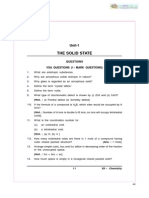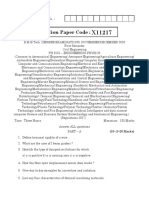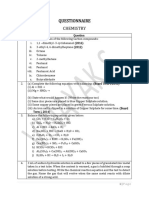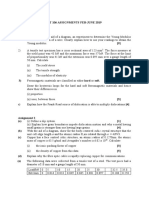Tutorial 1
Uploaded by
karanTutorial 1
Uploaded by
karanIndian Institute of Technology Roorkee
Department of Metallurgical and Materials Engineering
MT-202 Electrical and Electronic Materials
Tutorial 1
1.
i.
Consider a multicomponent alloy containing N elements. If w1, w2, w3,..,wN are
the weight fractions of the components 1, 2, 3, ..,N in the alloy and M1, M2,
M3,..,MN are the respective atomic masses of the elements, show that the
atomic fraction of the ith component is given by,
wi Mi
ni =
-----------------------------w1 M1+w2 M2+------------+wN MN
ii.
Consider the semiconducting II-VI compound cadmium selenide, CdSe. Given the
atomic masses of Cd and Se, find the weight fraction of Cd and Se in the
compound and grams of Cd and Se needed to make 100 grams of CdSe.
2.
Explain the general bonding principle of atoms to form a crystalline solid with the
help of energy verses inter-atomic distance plot.
3.
i.
State various physical and mechanical properties of materials.
ii.
Explain how the bonding type affect the above properties. Give examples.
Define and explain the following with the help of suitable diagrams
4.
i.
ii.
iii.
iv.
v.
vi.
5.
i.
ii.
iii.
iv.
v.
vi.
Space lattice
Unit cell and lattice parameters
Crystal systems
Bravais lattice and their classification
Origin for the creation of FCC Bravais lattice from a primitive cubic lattice
Crystal voids and their coordinates
Calculate the following:
Effective number of atoms in SC, BCC, FCC, HCP unit cells
Relationship between the size of the unit cell and atomic diameter in SC, BCC,
FCC, HCP unit cells
Packing factors of BCC, FCC, HCP unit cells
Packing factor of a diamond cubic crystal structure
Coordination numbers of BCC, FCC, HCP crystal lattice
c/a ratio for an ideal HCP unit cell
vii.
Size of largest sphere that can fit into the tetrahedral & octahedral interstitial sites
of a close packed structures without distorting the unit cell.
viii. Volume of unit cell of germanium in cubic meters, the atomic radius of Ge having
Diamond Cubic structure being 1.223 Ao
6.
7.
Show with the help of neat sketches the following:
i.
Planes whose Miller indices are (111), (210), (010), (0 ), (002), (130), (212)
and(3 2).
ii.
Directions whose Miller indices are [111], [110], [10], [122], [301], [201] and [2
3].
iii.
[1210], [01 0], [011] directions and (1210), ( 22), (1230) planes (Miller
Bravais Index) in HCP unit cell
In a cubic unit cell the (hkl) & [hkl] are perpendicular to each other
iv.
Miller index of the direction that is common to both planes (110) and (111) inside
the unit cell of a cubic crystal.
v.
3 parallel planes of belonging to {111} inside a cubic unit cell (may be touching
the UC).
vi.
6 direction <110> on any one {111}
i.
Given the Si lattice parameter a=0.543 nm. Calculate the number of Si atoms per unit volume, in
-3
nm .
ii.
Calculate the number of atoms per m and per nm on the (100), (110), and (111) planes in the Si
crystal as shown in above figure. Which plane has the maximum number of atoms per unit area?
iii.
-3
The density of SiO2 is 2.27 g cm . Given that its structure is amorphous, calculate the number of
-3
molecules per unit volume, in nm . Compare your result with (i) and comment on what happens
when the surface of a Si crystal oxidizes. The atomic masses of Si and O are 28.09 and 16,
respectively.
8.
In device fabrication, Si is frequently doped by the diffusion of impurities (dopants) at high
0
temperatures , typically 950-1200 C. The energy of vacancy formation in the Si crystal is about
0
3.6eV. What is the equilibrium concentration of vacancies in a Si crystal at 1000 C ? Neglect the
change in the density with temperature which is less than 1 percent in this case.
10.
11.
i.
Describe with neat sketches, the 3 types of line defects and relate b, Burgers vector with
dislocation line.
ii.
Describe planar defects ; grain boundaries and surface defects
iii.
How do the defects affect the electrical conductivity of the materials?
i.
What are the allotropically different forms of carbon?
ii.
Give neat sketches of their crystal structures.
iii.
How do you classify these materials in terms of electrical conductivity?
i.
Why single crystals are used for electronic applications? Explain methods of bulk single crystal
growth.
ii.
What is epitaxial growth? Explain with one example each of growth for; binary, ternary and
quaternary semiconductor compounds, with the help of Eg vs lattice parameter of the crystal
plot.
12.
13.
iii.
What is the significance of distribution coefficient in zone refining?
i.
How amorphous semiconductors are prepared? Give an example.
ii.
Explain how the nonstoichiometeric, ZnO crystal with excess Zn at the interstitial sites contribute
free electron for conduction.
Consider 50% Pb- 50% Sn solder alloy:
f13_07_pg196
You might also like
- Lectut-MTN-105-Doc-MT 201A-Tutorial - CH 1 (4 Files Merged)No ratings yetLectut-MTN-105-Doc-MT 201A-Tutorial - CH 1 (4 Files Merged)9 pages
- Tutorial QuTutorial Questions EE1003 - 15-16-S2 PDFNo ratings yetTutorial QuTutorial Questions EE1003 - 15-16-S2 PDF8 pages
- Tutorial - 2-1 - 230521 - 212904 - 230602 - 225042No ratings yetTutorial - 2-1 - 230521 - 212904 - 230602 - 2250428 pages
- Mechanical Properties and Its Testing MethodNo ratings yetMechanical Properties and Its Testing Method9 pages
- 12 Chemistry Important Questions Solid State 01No ratings yet12 Chemistry Important Questions Solid State 017 pages
- SC IT 7 - 10th CBSE P I&II - 07.01.2023 SCIENCENo ratings yetSC IT 7 - 10th CBSE P I&II - 07.01.2023 SCIENCE4 pages
- Solid State: Subjective Question For Board ExaminationNo ratings yetSolid State: Subjective Question For Board Examination14 pages
- Other Sources.: A4 Sheet Papers Submission Date - August 26, 27 and 28, 2019No ratings yetOther Sources.: A4 Sheet Papers Submission Date - August 26, 27 and 28, 20195 pages
- Grade 11 HL Chemistry-Revision Booklet 2022No ratings yetGrade 11 HL Chemistry-Revision Booklet 202219 pages
- Prepared by Beehive Digital Concepts Cochin For Mahatma Gandhi University KottayamNo ratings yetPrepared by Beehive Digital Concepts Cochin For Mahatma Gandhi University Kottayam21 pages
- APznzaY1SSDIpE77cDDHxj_HCH4D2NfKJmp2UnOq8uL7erkzcn6dabQ0xkJxdhucMIS6FHHFVA0eZd94AIYxhekgY2OdD8GvSxv0_BuJxD..._CwgEFKbCOznW53PtZQaae1IgHpDpN7qMz8KV-dXYAnMoE8Keb6xipWoQV4JAQLothfVwPA1m7gKRekzr27d8OSe0dvnmCDKSn3D0O0G1iwbYdzGXAAnmlPV0=No ratings yetAPznzaY1SSDIpE77cDDHxj_HCH4D2NfKJmp2UnOq8uL7erkzcn6dabQ0xkJxdhucMIS6FHHFVA0eZd94AIYxhekgY2OdD8GvSxv0_BuJxD..._CwgEFKbCOznW53PtZQaae1IgHpDpN7qMz8KV-dXYAnMoE8Keb6xipWoQV4JAQLothfVwPA1m7gKRekzr27d8OSe0dvnmCDKSn3D0O0G1iwbYdzGXAAnmlPV0=11 pages
- Engineering Physics - I - PH6151 Important 2 Marks With Answers100% (4)Engineering Physics - I - PH6151 Important 2 Marks With Answers23 pages
- Question Bank For First Year First Sem Question Bank For Physics-I Regulation 20913No ratings yetQuestion Bank For First Year First Sem Question Bank For Physics-I Regulation 2091321 pages
- Universiti Pendidikan Sultan Idris Test SEMESTER 1 SESSION 2020/2021No ratings yetUniversiti Pendidikan Sultan Idris Test SEMESTER 1 SESSION 2020/202112 pages
- PG, 1 Sem, Apc, CC-1, Question Paper - Jan 23No ratings yetPG, 1 Sem, Apc, CC-1, Question Paper - Jan 233 pages
- Advanced Thermoelectric MaterialsFrom EverandAdvanced Thermoelectric MaterialsChong Rae ParkNo ratings yet
- Small-Scale Production of Portland Cement (HABITAT, 1993, 92 P.) V. Raw-Mix Design and Quality Control in VSK Cement Plants 5.1 Raw-Mix DesignNo ratings yetSmall-Scale Production of Portland Cement (HABITAT, 1993, 92 P.) V. Raw-Mix Design and Quality Control in VSK Cement Plants 5.1 Raw-Mix Design3 pages
- Introduction To Biodiesel Chemistry Terms and Background InformationNo ratings yetIntroduction To Biodiesel Chemistry Terms and Background Information5 pages
- 2023 Fy13ce Chemistry Detailed SolutionsNo ratings yet2023 Fy13ce Chemistry Detailed Solutions16 pages
- Process That Drastically Decreases The Time Needed To Build A Shell For Investment Casting. Silicate That Is Added To The Stucco. MethodsNo ratings yetProcess That Drastically Decreases The Time Needed To Build A Shell For Investment Casting. Silicate That Is Added To The Stucco. Methods1 page
- Application of Zeolite Based Nanocomposites For Wastewater Remediation Evaluating Newer and Environmentally Benign ApproachesNo ratings yetApplication of Zeolite Based Nanocomposites For Wastewater Remediation Evaluating Newer and Environmentally Benign Approaches11 pages
- Ionic Liquids Enhanced Performance of PVC Gels ActuatorNo ratings yetIonic Liquids Enhanced Performance of PVC Gels Actuator7 pages
- Mohamed Bulbul - Acids, Alkalis and Titrations QPNo ratings yetMohamed Bulbul - Acids, Alkalis and Titrations QP15 pages
- Proteins Covalent Structure - Biochemistry Questions and Answers - SanfoundryNo ratings yetProteins Covalent Structure - Biochemistry Questions and Answers - Sanfoundry1 page
- Investigation On Improve Ash Fusion Temperature (AFT) of low-AFT Coal by Biomass AdditionNo ratings yetInvestigation On Improve Ash Fusion Temperature (AFT) of low-AFT Coal by Biomass Addition9 pages
- TiO2 NP Modified Ground Nut Shell Based AC For IBUPROFEN RemovalNo ratings yetTiO2 NP Modified Ground Nut Shell Based AC For IBUPROFEN Removal17 pages
- Linear Low-Density (LLDPE) : Main ArticleNo ratings yetLinear Low-Density (LLDPE) : Main Article4 pages
- Inorganic Chemistry Communications: Harshal Dabhane, Manohar Zate, Ramdas Bharsat, Ghanshyam Jadhav, Vijay MedhaneNo ratings yetInorganic Chemistry Communications: Harshal Dabhane, Manohar Zate, Ramdas Bharsat, Ghanshyam Jadhav, Vijay Medhane11 pages
- Definitions - Organic Chemistry II - AQA Chemistry A-LevelNo ratings yetDefinitions - Organic Chemistry II - AQA Chemistry A-Level11 pages
- Lectut-MTN-105-Doc-MT 201A-Tutorial - CH 1 (4 Files Merged)Lectut-MTN-105-Doc-MT 201A-Tutorial - CH 1 (4 Files Merged)
- Tutorial QuTutorial Questions EE1003 - 15-16-S2 PDFTutorial QuTutorial Questions EE1003 - 15-16-S2 PDF
- Tutorial - 2-1 - 230521 - 212904 - 230602 - 225042Tutorial - 2-1 - 230521 - 212904 - 230602 - 225042
- Solid State: Subjective Question For Board ExaminationSolid State: Subjective Question For Board Examination
- Other Sources.: A4 Sheet Papers Submission Date - August 26, 27 and 28, 2019Other Sources.: A4 Sheet Papers Submission Date - August 26, 27 and 28, 2019
- Prepared by Beehive Digital Concepts Cochin For Mahatma Gandhi University KottayamPrepared by Beehive Digital Concepts Cochin For Mahatma Gandhi University Kottayam
- APznzaY1SSDIpE77cDDHxj_HCH4D2NfKJmp2UnOq8uL7erkzcn6dabQ0xkJxdhucMIS6FHHFVA0eZd94AIYxhekgY2OdD8GvSxv0_BuJxD..._CwgEFKbCOznW53PtZQaae1IgHpDpN7qMz8KV-dXYAnMoE8Keb6xipWoQV4JAQLothfVwPA1m7gKRekzr27d8OSe0dvnmCDKSn3D0O0G1iwbYdzGXAAnmlPV0=APznzaY1SSDIpE77cDDHxj_HCH4D2NfKJmp2UnOq8uL7erkzcn6dabQ0xkJxdhucMIS6FHHFVA0eZd94AIYxhekgY2OdD8GvSxv0_BuJxD..._CwgEFKbCOznW53PtZQaae1IgHpDpN7qMz8KV-dXYAnMoE8Keb6xipWoQV4JAQLothfVwPA1m7gKRekzr27d8OSe0dvnmCDKSn3D0O0G1iwbYdzGXAAnmlPV0=
- Engineering Physics - I - PH6151 Important 2 Marks With AnswersEngineering Physics - I - PH6151 Important 2 Marks With Answers
- Question Bank For First Year First Sem Question Bank For Physics-I Regulation 20913Question Bank For First Year First Sem Question Bank For Physics-I Regulation 20913
- Universiti Pendidikan Sultan Idris Test SEMESTER 1 SESSION 2020/2021Universiti Pendidikan Sultan Idris Test SEMESTER 1 SESSION 2020/2021
- Small-Scale Production of Portland Cement (HABITAT, 1993, 92 P.) V. Raw-Mix Design and Quality Control in VSK Cement Plants 5.1 Raw-Mix DesignSmall-Scale Production of Portland Cement (HABITAT, 1993, 92 P.) V. Raw-Mix Design and Quality Control in VSK Cement Plants 5.1 Raw-Mix Design
- Introduction To Biodiesel Chemistry Terms and Background InformationIntroduction To Biodiesel Chemistry Terms and Background Information
- Process That Drastically Decreases The Time Needed To Build A Shell For Investment Casting. Silicate That Is Added To The Stucco. MethodsProcess That Drastically Decreases The Time Needed To Build A Shell For Investment Casting. Silicate That Is Added To The Stucco. Methods
- Application of Zeolite Based Nanocomposites For Wastewater Remediation Evaluating Newer and Environmentally Benign ApproachesApplication of Zeolite Based Nanocomposites For Wastewater Remediation Evaluating Newer and Environmentally Benign Approaches
- Ionic Liquids Enhanced Performance of PVC Gels ActuatorIonic Liquids Enhanced Performance of PVC Gels Actuator
- Proteins Covalent Structure - Biochemistry Questions and Answers - SanfoundryProteins Covalent Structure - Biochemistry Questions and Answers - Sanfoundry
- Investigation On Improve Ash Fusion Temperature (AFT) of low-AFT Coal by Biomass AdditionInvestigation On Improve Ash Fusion Temperature (AFT) of low-AFT Coal by Biomass Addition
- TiO2 NP Modified Ground Nut Shell Based AC For IBUPROFEN RemovalTiO2 NP Modified Ground Nut Shell Based AC For IBUPROFEN Removal
- Inorganic Chemistry Communications: Harshal Dabhane, Manohar Zate, Ramdas Bharsat, Ghanshyam Jadhav, Vijay MedhaneInorganic Chemistry Communications: Harshal Dabhane, Manohar Zate, Ramdas Bharsat, Ghanshyam Jadhav, Vijay Medhane
- Definitions - Organic Chemistry II - AQA Chemistry A-LevelDefinitions - Organic Chemistry II - AQA Chemistry A-Level

























































































